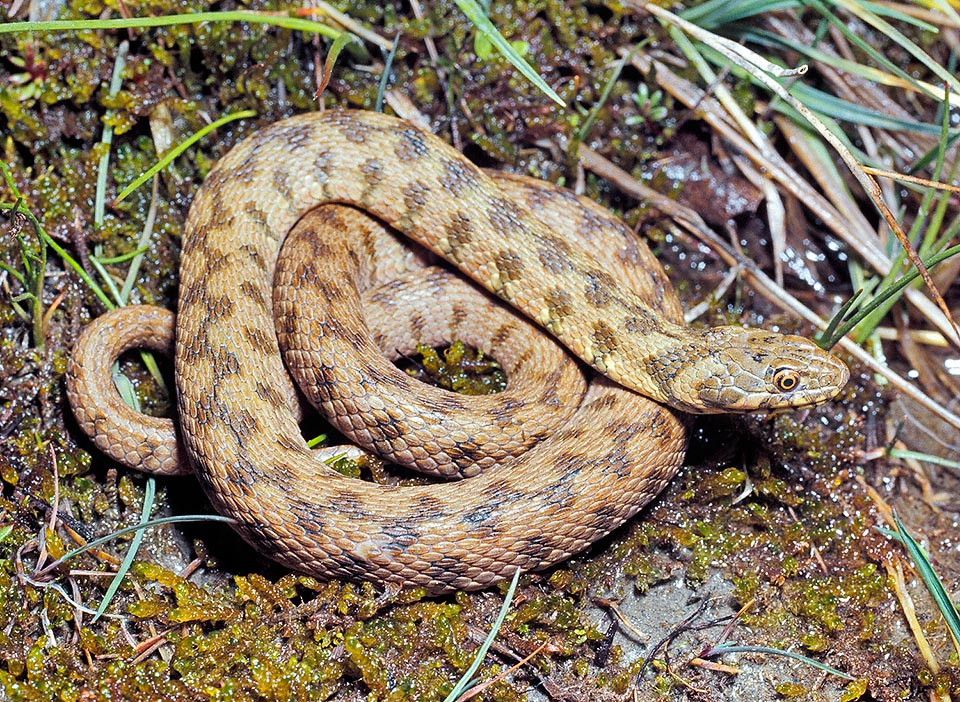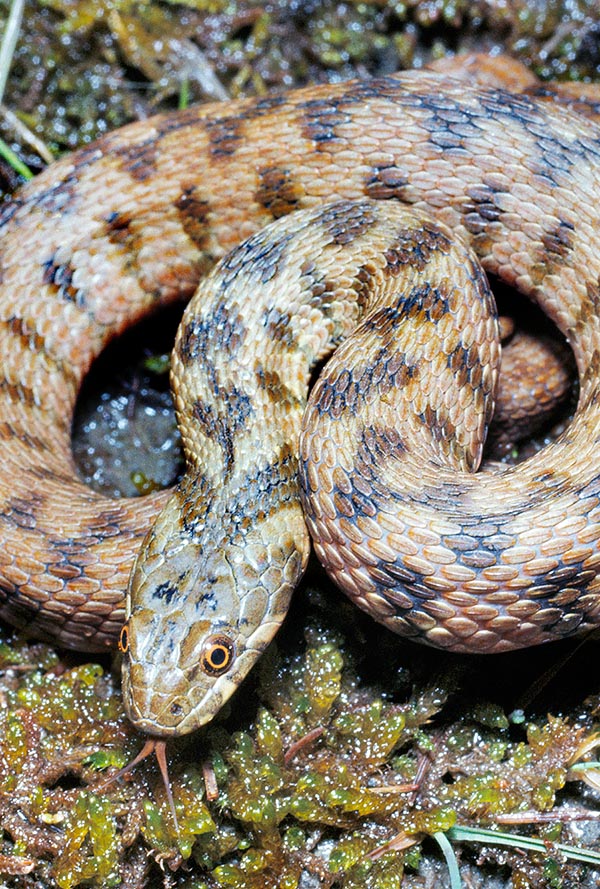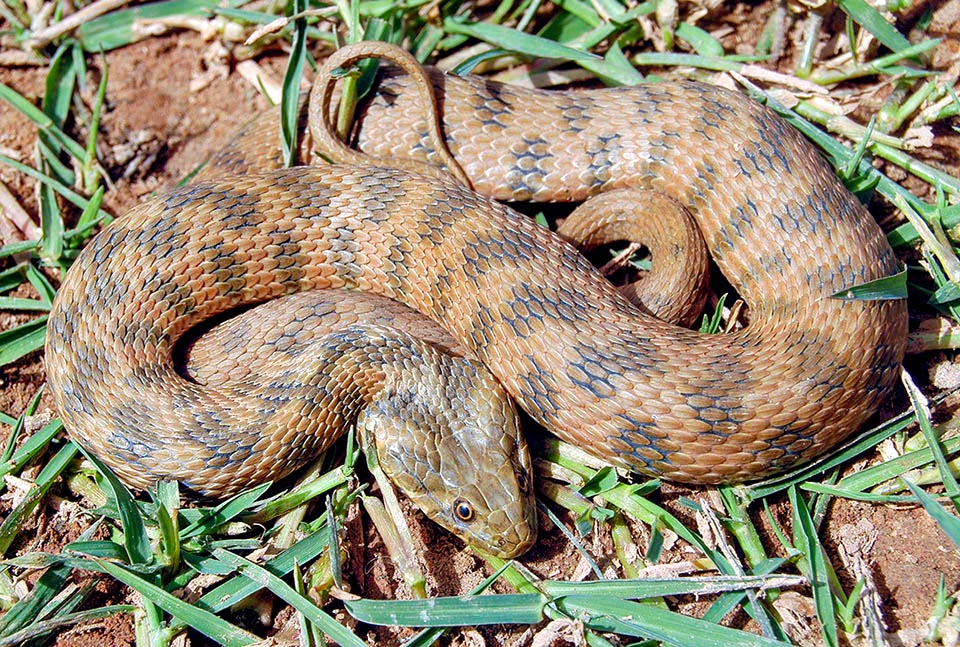Family : Colubridae

Text © Dr. Carlo Zucchi

English translation by Mario Beltramini
Present in Western Europe, the Viperine snake (Natrix maura Linnaeus, 1758) is an elegant snake very linked to aquatic environments.
It belongs to the subfamily Natricinae (family Colubridae) or, after some Authors, to the family Natricidae. The name of the genus Natrix comes from the Latin “natrix,-icis”, that is, water snake, whilst the specific name maura, always from the Latin “maurus, a, um”, of Mauretania, evokes this region.
The vulgar name of viperine snake refers to the particular defensive habits of the animal: when menaced and with no escape route, this snake blows repeatedly, flattens head and body and strikes in the air. Together with its dark zigzagging livery on the back, these elements make it look like an adder thus discouraging possible predators. If grabbed, it then emits faeces and malodorous substances from the cloacal glands with a repellent deterrent effect but is absolutely harmless for the man, being a non-poisonous species.
Zoogeography
The Natrix maura is distributed in Western Europe and North Africa: from the Iberian Peninsula, Spain and Portugal, to central-southern France up to the extreme west of Switzerland, north-western Italy and some islands of Mediterranean (Sardinia and lesser close islands, introduced in the Balearics) passing through Morocco, Algeria and north-western Libya.

Frequent in western Europe and in North Africa, the Natrix maura is a harmless terricolous diurnal snake, deeply linked to the water © Giuseppe Mazza
This is a monotypic species but recent genetic studies have evidenced its diversity inside of its range: we can note three haplotypes that might lead to think to three subspecies present respectively in Morocco, Algeria-Tunisia-Sardinia and continental Europe.
Ecology-Habitat
The viperine snake frequents a wide variety of habitats all having in common the presence of water or of high humidity. Hence it can be found along water streams, rivers, lakes, puddles, ponds, swamps, humid meadows but even in estuaries and marine zones close to the coasts, as it tolerates salinity well. The discriminating elements are the presence of a good vegetable coverage and suitable sites of thermoregulation. The individuals may be numerous along the streams of backwater or with weak current; moreover the home range is limited to few hundreds of metres: in fact the animal moves to reach other sheets of water, to get the food or for the social interactions.
For what concerns the altitude it is possible to observe it from the sea level up to about 1200-1400 m reaching the 2500 m in North Africa. Like other species it is possible to observe a typical distribution scheme: in the coldest zones, northwards, Natrix maura is confined to the low altitudes, whilst in the warmest zones, southwards (North Africa), it reaches rather higher altitudes. In anthropized zones it can be met even in artificial structures such as troughs, irrigation canals and ponds for fishing.

Similar, also in the reactions, to an adder, it eats fish, amphibians and invertebrates © Giuseppe Mazza
It is therefore a terricolous snake, diurnal and deeply linked to the water even if are reported observations on populations with markedly terrestrial life in zones of North Africa.
After the wintering that takes place in abandoned dens, cavities in the ground, in the vegetation or other suitable shelters often with presence of numerous conspecific individuals or of other species, the viperine snake resumes its activity in the period going from March to October. Depending on the location and the season there is also a variation in the daily period of activity.
Morphophysiology
It is a medium-sized snake that does not exceed the metre, usually reaching about 60 cm in the males and 90 cm in the females.
The head is wide and flattened, slightly pointed towards the extremity, big eyes and slightly bent upwards, equipped with round pupils and orange iris; also the nostrils are slightly bent upwards, signs of an adaptation to a mainly aquatic life. The body is fairly slender and the females differ from the males, besides the size, for the tail, proportionally shorter, and the trunk longer than that of the partners.
The lepidote characteristics, that is of the scales, are as follows: usually 2 preocular scales, 2 postocular, 7 supralabials (the 3rd and the 4th touch the eyes), 9 sublabials, 2 rows of scales ar mid trunk, 146-162 ventrals, divided anal scale, 44-73 subcaudals. Furthermore the scales are big and smooth on the head, and smaller and keeled on the rest of the body.
The background colouring is brownish-greyish-olive with ornamentations typical to the species, that serve also for distinguishing it from the similar Natrix tessellata and Natrix natrix.
On the back of the head are present inverted V spots open towards the neck; on the vertebral zone show up two staggered rows of dark spots, often united to form a zigzag; on the sides stand characteristic rows of dark spots with paler centre called ocelli; finally, the ventral part, of whitish-yellowish colour, is ornamented with big and dark spots arranged in blocks.
It is worth to note that the ventral pattern remains constant during the life, thus allowing the identification of the single individuals. In some populations is present a livery with showy pale dorsolateral lines. The young have a colouration similar to the adults’ one.
Ethology-Reproductive Biology
The viperine snake is a harmless species, not poisonous and little aggressive. If disturbed, it escapes quickly, but if cornered, as already said, shows threatening attitudes, blowing and expanding the rear head with fake attacks with closed mouth and if seized emits smelly faeces and substances.
The diet, typically aquatic, mainly includes fishes, amphibians and invertebrates. The preys are actively hunted or the viperine snake keeps quietly on the bottom, in ambush, with the rear part of the body anchored to the substratum and with the fore part ready to spring up upon the passage of a potential prey. The food is consumed directly in water, or if the loot is big, on the dry land.

The females, bigger than males, reach the 90 cm. They lay 3-16 eggs that hatch in July © Daniel Jablonski
After wintering, begins the reproductive period with the males exploring the territory looking for females; often more males stay in the same time close to a single female courting it. The one who has the better among the pretenders, wraps it among its spires repeatedly rubbing the head on the back.
After the preliminaries occurs the mating that usually takes place between March and May. The fecundated female, when ready, looks for the site suitable for laying 3 to 15 eggs: usually a warm and humid hole or a pile of debris.
In July, after about one month, the hatch occurs. The young, initially 14-20 cm long, reach the sexual maturity between the 3 and 5 years of age. It is worth to note that the males mature about one year before and with smaller size in respect to the females.
The timings of the various phases of the reproduction are in function to the size of the mother, the scarcity or abundance of food and the environmental characteristics.
Synonyms
Coluber maurus, Linnaeus 1758; Coluber viperinus, Sonnini & Latreille 1802; Natrix cherseoides, Wagler 1824; Natrix ocellata, Wagler 1824; Tropidonotus viperinus, Duméril, Bibron & Duméril 1854; Tropidonotus cherseoides, Duméril, Bibron & Duméril 1854; Natrix viperina, Fejervary 1927.
→ For general notions about Serpentes please click here.
→ To appreciate the biodiversity within the SNAKES please click here.
